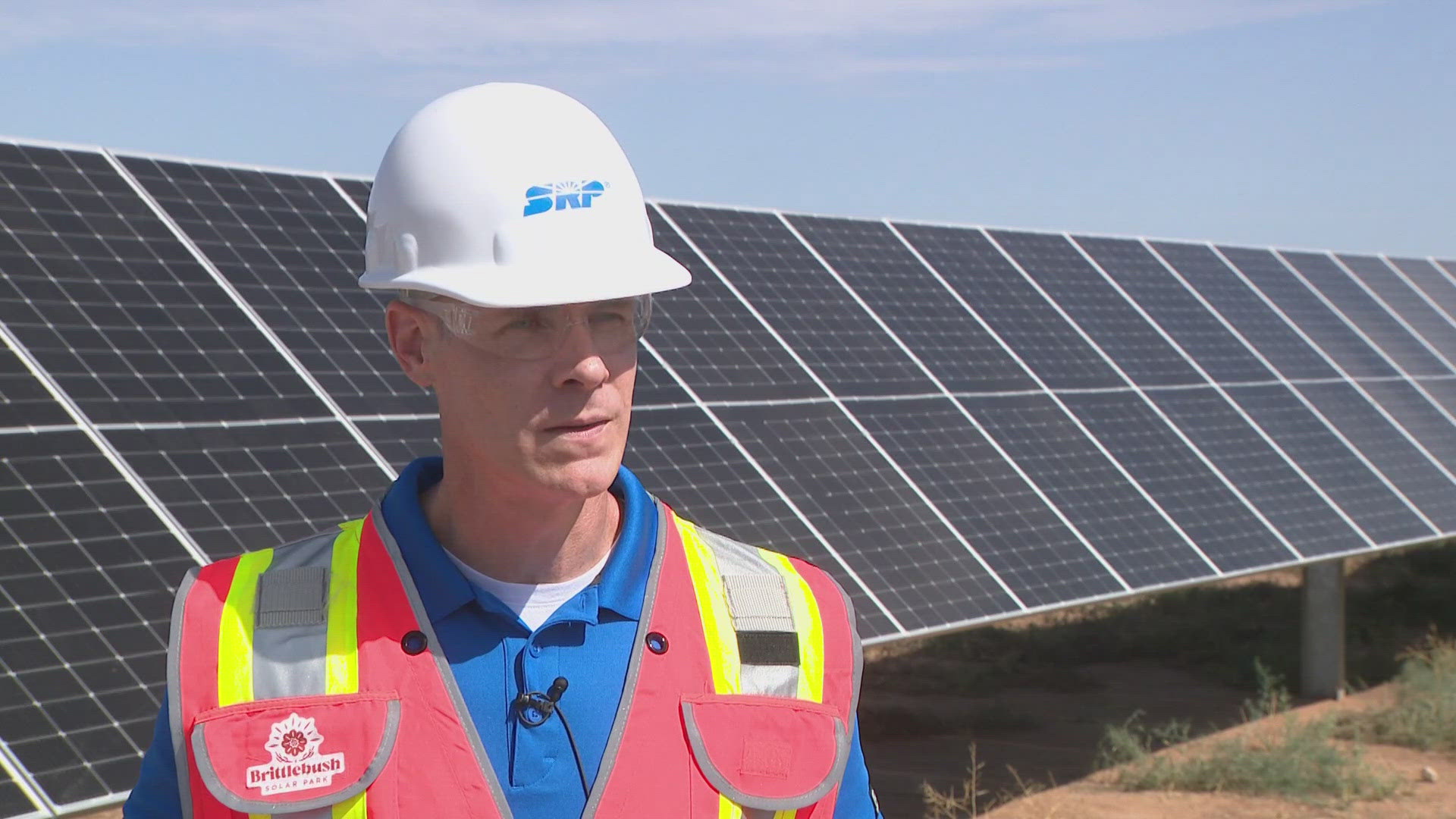COOLIDGE, Ariz. — In Arizona, there's no shortage of sunshine. Companies like Salt River Project and EDP Renewables North America are working together to transform solar energy into a more sustainable life in State 48.
One of those ways is with the new Brittlebush Solar Park.
The facility was recently completed and started serving customers in July 2024. Although the solar park is in Coolidge, Brittlebush's 500,000 solar panels serve roughly 45,000 Valley homes. That's a lot of power. This solar park started operating just in time to meet the peak summer energy demand.
SRP Director of Resource Planning Grant Smedley tells 12News they are seeing a big expansion is who they serve.
"We're seeing just explosive growth in our service territory," he said. "And so it's important we add power generation resources to help maintain reliability as we see that growth."
Brittlebush Solar Park is owned and operated by EDP Renewables. The output from the facility goes to SRP. This is one of SRP's newest generation resources.
"This solar park is a little bit unique," Smedley explained. "We have an agreement with one of our large customers, Meta, who has a goal to power their data center using 100 percent renewable energy, so we have an agreement with them to allocate the output of this facility to help them meet that goal...and they actually pay a premium for that output, which helps to reduce costs for our other customers."
He also said the park would be pivotal in the long term.
"This facility is going to produce carbon-free energy throughout the day, so that's really going to help us meet our long-term sustainability goals," Smedley emphasized.
Kelly Snyder, EDPR Senior Director of Origination, also noted the need for solar power.
"It's important from a water conservation standpoint. From the idea of solar really being able to conserve water is hugely important for the desert and the Valley area," Snyder said. "This project conserves about 254 million gallons of water compared to a traditional source of generation."
Brittlebush Solar Park is one of several other facilities that will be added in the near future.
"Facilities like this one and other types of power generation we're adding are going to be a really important part of our ability to continue to sustain life in the desert for years to come," Smedley said.
But how exactly does solar energy work?
Photovoltaic (PV) devices generate electricity directly from the sun; this happens through electronic processes that naturally occur in certain types of material called semiconductors.
Electrons in these materials are freed by solar energy and can be induced to travel through an electrical circuit, powering electrical devices or sending electricity to the grid. Photons strike and ionize semiconductor material on the solar panel, causing outer electrons to break free of their atomic bonds.
Due to the semiconductor structure, the electrons are forced in one direction, creating a flow of electrical current. Solar cells are not 100 percent efficient in crystalline silicon solar cells, in part because only certain light within the spectrum can be absorbed. Some of the light spectrum is reflected, some is too weak to create electricity (infrared) and some (ultraviolet) creates heat energy instead of electricity.
Photovoltaic devices can be used to power anything from small electronics, like calculators and road signs, to homes and large commercial businesses.
To help address climate change, solar energy set a goal to reach 30 percent electricity generation by 2030. Today, more than five percent of U.S. electricity comes from solar energy, nearly eight times its share a decade ago.
According to Solar Energy Industries Association (SEIA), a new solar project was installed every 39 seconds in 2023. By 2030, SEIA projects that 15 percent of homes will have a solar PV system. Solar Energy Industries Association reports the top ten corporate solar users through June 2022 are:
- Meta - 3,588.1 MW
- Amazon - 1,114.5 MW
- Apple - 987.3 MW
- Walmart - 688.9 MW
- Microsoft - 550.6 MW
- Target - 515.1 MW
- Cargill - 342.0 MW
- Kaiser Permanente - 302.5 MW
- Anheuser-Busch - 300.7 MW
- Evraz North America - 300.0 MW
According to SEIA, the top ten U.S. states ranking by cumulative solar capacity are:
- 1. California - 46,874 MW
- 2. Texas - 22,872 MW
- 3. Florida - 13,912 MW
- 4. North Carolina - 9,310 MW
- 5. Arizona - 7,675 MW
- 6. Nevada - 6,382 MW
- 7. Georgia - 5,913 MW
- 8. New York - 5,560 MW
- 9. New Jersey - 5,276 MW
- 10. Massachusetts - 5,070 MW
In the next ten years, SEIA projects 450 GW of new solar capacity will be installed.
>> Download the 12News app for the latest local breaking news straight to your phone.
12News on YouTube
Catch up on the latest news and stories on the 12News YouTube channel. Subscribe today.

